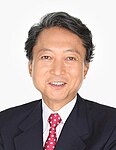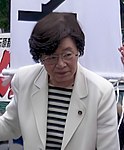2000 Japanese general election
| |||||||||||||||||||||||||||||||||||||||||||||||||||||||||||||||||||||||||||||||||||||||||||||
All 480 seats in the House of Representatives 241 seats needed for a majority | |||||||||||||||||||||||||||||||||||||||||||||||||||||||||||||||||||||||||||||||||||||||||||||
|---|---|---|---|---|---|---|---|---|---|---|---|---|---|---|---|---|---|---|---|---|---|---|---|---|---|---|---|---|---|---|---|---|---|---|---|---|---|---|---|---|---|---|---|---|---|---|---|---|---|---|---|---|---|---|---|---|---|---|---|---|---|---|---|---|---|---|---|---|---|---|---|---|---|---|---|---|---|---|---|---|---|---|---|---|---|---|---|---|---|---|---|---|---|
| Turnout | 62.49% ( 62.45% ( | ||||||||||||||||||||||||||||||||||||||||||||||||||||||||||||||||||||||||||||||||||||||||||||
| |||||||||||||||||||||||||||||||||||||||||||||||||||||||||||||||||||||||||||||||||||||||||||||
 Districts and PR districts, shaded according to winners' vote strength | |||||||||||||||||||||||||||||||||||||||||||||||||||||||||||||||||||||||||||||||||||||||||||||
| |||||||||||||||||||||||||||||||||||||||||||||||||||||||||||||||||||||||||||||||||||||||||||||
| This article is part of a series on |
 |
|---|
|
|
General elections were held in Japan on 25 June 2000 to elect the 480 members of the House of Representatives.
The ruling Liberal Democratic Party (LDP) remained the largest party in the House of Representatives but lost seats, along with its two coalition partners. Two cabinet members, Takashi Fukaya and Tokuichiro Tamazawa, lost their seats. The Democratic Party made major gains under the leadership of Yukio Hatoyama.[1]
Background
[edit]Prime Minister Keizo Obuchi suffered a stroke in April 2000 and was replaced by Yoshiro Mori. Although the term limit for the House of Representatives would have been reached in October 2000, Mori dissolved the House on June 2 in what became popularly known as the Divine Nation Dissolution (神の国解散) due to a controversial statement by Mori prior to the election, which preceded a slump in government approval ratings from 40% to 20%. The LDP government advocated continued public works spending while the opposition advocated less spending and more governmental reforms.[2]
The Social Democratic Party left the coalition in 1998 and re-join the opposition after years of coalition with the ideologically contrasting LDP.
Meanwhile, the Komeito Party, a centrist party with roots from the Soka Gakkai based on the Nichiren Buddhist movement and despite almost decades of opposition against the LDP, shifted from centre towards conservatism. An electoral alliance between the once rivals of the Komeito and the LDP has been in effect since the Japanese General election in 2000. For the LDP, despite not being able to win an absolute majority of votes by itself in further elections (especially for the House of Councillors which the LDP lost majority since 1989), the Komeito party has been counted on since then to ensure a stable governing majority rule.
Results
[edit]
The House of Representatives consisted of 480 members, 300 elected from single-member constituencies and 180 elected on a proportional basis from eleven multi-member constituencies known as Block constituencies.
 | |||||||||
|---|---|---|---|---|---|---|---|---|---|
| Party | Proportional | Constituency | Total seats | +/– | |||||
| Votes | % | Seats | Votes | % | Seats | ||||
| Liberal Democratic Party | 16,943,425 | 28.31 | 56 | 24,945,807 | 40.97 | 177 | 233 | –6 | |
| Democratic Party of Japan | 15,067,990 | 25.18 | 47 | 16,811,732 | 27.61 | 80 | 127 | New | |
| New Komeito Party | 7,762,032 | 12.97 | 24 | 1,231,753 | 2.02 | 7 | 31 | New | |
| Japanese Communist Party | 6,719,016 | 11.23 | 20 | 7,352,844 | 12.08 | 0 | 20 | –6 | |
| Liberal Party | 6,589,490 | 11.01 | 18 | 2,053,736 | 3.37 | 4 | 22 | New | |
| Social Democratic Party | 5,603,680 | 9.36 | 15 | 2,315,235 | 3.80 | 4 | 19 | +4 | |
| Liberal League | 660,724 | 1.10 | 0 | 1,071,012 | 1.76 | 1 | 1 | New | |
| New Conservative Party | 247,334 | 0.41 | 0 | 1,230,464 | 2.02 | 7 | 7 | New | |
| Assembly of Independents | 151,345 | 0.25 | 0 | 652,138 | 1.07 | 5 | 5 | New | |
| Other parties | 99,565 | 0.17 | 0 | 250,681 | 0.41 | 0 | 0 | – | |
| Independents | 2,967,069 | 4.87 | 15 | 15 | +6 | ||||
| Total | 59,844,601 | 100.00 | 180 | 60,882,471 | 100.00 | 300 | 480 | –20 | |
| Valid votes | 59,844,601 | 95.37 | 60,882,471 | 97.01 | |||||
| Invalid/blank votes | 2,904,983 | 4.63 | 1,877,318 | 2.99 | |||||
| Total votes | 62,749,584 | 100.00 | 62,759,789 | 100.00 | |||||
| Registered voters/turnout | 100,492,328 | 62.44 | 100,433,798 | 62.49 | |||||
| Source: Election Resources, IPU | |||||||||
By prefecture
[edit]| Prefecture | Total seats |
Seats won | ||||||||
|---|---|---|---|---|---|---|---|---|---|---|
| LDP | DPJ | NKP | NCP | AI | SDP | LP | LL | Ind. | ||
| Aichi | 15 | 5 | 9 | 1 | ||||||
| Akita | 3 | 3 | ||||||||
| Aomori | 4 | 3 | 1 | |||||||
| Chiba | 12 | 7 | 5 | |||||||
| Ehime | 4 | 4 | ||||||||
| Fukui | 3 | 3 | ||||||||
| Fukuoka | 11 | 8 | 2 | 1 | ||||||
| Fukushima | 5 | 3 | 1 | 1 | ||||||
| Gifu | 5 | 5 | ||||||||
| Gunma | 5 | 5 | ||||||||
| Hiroshima | 7 | 5 | 1 | 1 | ||||||
| Hokkaido | 13 | 7 | 6 | |||||||
| Hyōgo | 12 | 3 | 3 | 2 | 2 | 1 | 1 | |||
| Ibaraki | 7 | 5 | 1 | 1 | ||||||
| Ishikawa | 3 | 3 | ||||||||
| Iwate | 4 | 1 | 3 | |||||||
| Kagawa | 3 | 2 | 1 | |||||||
| Kagoshima | 5 | 4 | 1 | |||||||
| Kanagawa | 17 | 9 | 6 | 1 | 1 | |||||
| Kōchi | 3 | 3 | ||||||||
| Kumamoto | 5 | 2 | 1 | 1 | 1 | |||||
| Kyoto | 6 | 5 | 1 | |||||||
| Mie | 5 | 2 | 2 | 1 | ||||||
| Miyagi | 6 | 2 | 4 | |||||||
| Miyazaki | 3 | 3 | ||||||||
| Nagano | 5 | 3 | 2 | |||||||
| Nagasaki | 4 | 2 | 1 | 1 | ||||||
| Nara | 4 | 4 | ||||||||
| Niigata | 6 | 4 | 1 | 1 | ||||||
| Ōita | 4 | 2 | 1 | 1 | ||||||
| Okayama | 5 | 5 | ||||||||
| Okinawa | 3 | 1 | 1 | 1 | ||||||
| Osaka | 19 | 8 | 5 | 4 | 1 | 1 | ||||
| Saga | 3 | 3 | ||||||||
| Saitama | 14 | 6 | 6 | 1 | 1 | |||||
| Shiga | 3 | 2 | 1 | |||||||
| Shimane | 3 | 3 | ||||||||
| Shizuoka | 9 | 4 | 4 | 1 | ||||||
| Tochigi | 5 | 4 | 1 | |||||||
| Tokushima | 3 | 2 | 1 | |||||||
| Tokyo | 25 | 8 | 13 | 1 | 3 | |||||
| Tottori | 2 | 2 | ||||||||
| Toyama | 3 | 3 | ||||||||
| Wakayama | 3 | 1 | 1 | 1 | ||||||
| Yamagata | 4 | 3 | 1 | |||||||
| Yamaguchi | 4 | 3 | 1 | |||||||
| Yamanashi | 3 | 2 | 1 | |||||||
| Total | 300 | 177 | 80 | 7 | 7 | 5 | 4 | 4 | 1 | 15 |
By PR block
[edit]| PR block | Total seats |
Seats won | |||||
|---|---|---|---|---|---|---|---|
| LDP | DPJ | NKP | JCP | LP | SDP | ||
| Chūgoku | 11 | 4 | 2 | 2 | 1 | 1 | 1 |
| Hokkaido | 8 | 2 | 3 | 1 | 1 | 1 | |
| Hokuriku–Shinetsu | 11 | 4 | 3 | 1 | 1 | 1 | 1 |
| Kinki | 30 | 7 | 7 | 5 | 5 | 3 | 3 |
| Kyushu | 21 | 7 | 4 | 3 | 2 | 2 | 3 |
| Northern Kanto | 20 | 7 | 5 | 3 | 2 | 2 | 1 |
| Shikoku | 6 | 3 | 1 | 1 | 1 | ||
| Southern Kanto | 21 | 6 | 6 | 3 | 2 | 2 | 2 |
| Tohoku | 14 | 5 | 3 | 1 | 1 | 3 | 1 |
| Tokai | 21 | 7 | 7 | 2 | 2 | 2 | 1 |
| Tokyo | 17 | 4 | 6 | 2 | 2 | 2 | 1 |
| Total | 180 | 56 | 47 | 24 | 20 | 18 | 15 |
Analysis
[edit]The further entrenchment of the 1955 System continued, with the Democratic Party of Japan replacing the New Frontier Party as the primary opposition to the LDP. The Social Democratic Party saw a brief resurgence following its near destruction in 1996, but the decline of the party would continue in the following election. The election set the groundwork for the system of politics that would lay how Japanese elections work until the collapse of the Democratic Party of Japan in the mid-2010s.
References
[edit]- ^ French, Howard (26 June 2000). "GOVERNING PARTY IN JAPAN SUFFERS ELECTION SETBACK". New York Times. Retrieved 27 January 2014.
- ^ "JAPAN Parliamentary Chamber: Shugiin ELECTIONS HELD IN 2000". IPU.org. Retrieved 27 January 2014.






